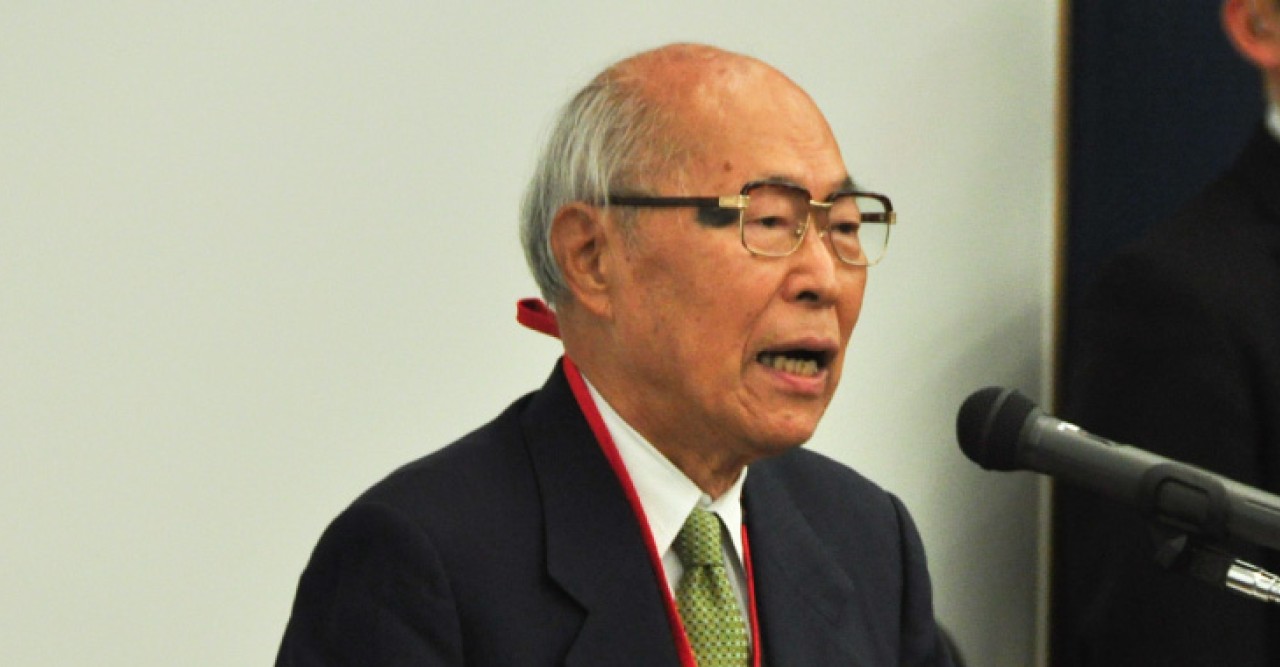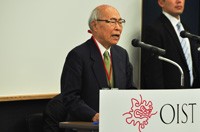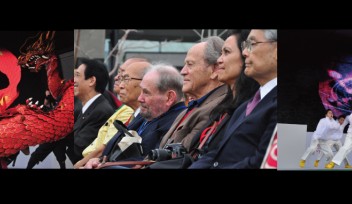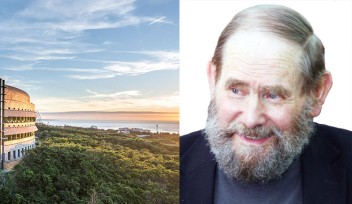Okinawa Triggers Internationalization of Japanese Universities

Dr. Akito Arima’s passion for seeing Japanese universities becoming truly international institutions was echoed in his thorough speech that reflected his efforts, and that of the National Diet, the government and industry. To Dr. Arima, achieving internationalization means that Japanese universities are open to external and independent assessments, comprise of strong international faculty and use English as the primary language of research and education. The birth of OIST has triggered this hope with its five pillars; “Best in the world, International, Flexible, Global Network and Collaboration with Industry.” Dr. Arima’s full speech can be found below.

I truly am happy to see this ceremony take place commemorating the founding of the Okinawa Institute of Science and Technology School Corporation. I would like to express my heartfelt gratitude for the efforts of the many people who have contributed in diverse ways at various stages of the process through today. I am truly, truly grateful to the successive ministers responsible, including former minister Koji Omi, who made substantial contributions from the time the graduate university plan was proposed and the first steps taken toward its realization, and Yuriko Koike, who worked toward establishment of the Okinawa Institute of Science and Technology Promotion Corporation, and Minister Tatsuo Kawabata, who pushed the final button on establishment of the corporation, as well as the members of the Cabinet Office who supported them, along with the people of Okinawa including former governor of Okinawa Prefecture Keiichi Inamine, current governor Hirokazu Nakaima, and Mayor Fumiyasu Shikiya of Onna Village.
I also would like to express my heartfelt gratitude to the researchers and staff members who have made repeated dedicated efforts toward establishment of the graduate university since the founding of the Okinawa Institute of Science and Technology Promotion Corporation, including Drs. Sydney Brenner and Bob Baughman, and my humble gratitude for the enthusiasm of Dr. Jonathan Dorfan, who has strived to put the finishing touches on the opening of the new graduate university as its president-elect and finally is preparing to act as its president.
I also would like to express my deep, deep appreciation for the great enthusiasm and efforts of Drs. Torsten Wiesel, Jerome Friedman, Martin Rees, Tim Hunt, Yuan Tseh Lee, Susumu Tonegawa, Ichiro Kanazawa, Hiroko Sho, and Kiyoshi Kurokawa who have taken part in repeated discussions toward realization of the graduate university from the planning stage through today. (Table 1)
From 1980 through today, I have continued my own humble efforts based on the idea that there must be some way to make Japanese universities into truly international institutions. I began by striving to improve the research and educational environments and increase research funding. Happily, thanks to the efforts of the National Diet, the government, industry, and others, great improvements have been made on this aspect in comparison with 20 years ago. In particular, the establishment in 1995 of the Science and Technology Basic Law has redoubled the energy of Japanese universities and research institutes, becoming a very strong source of power. I would like to thank all who worked toward the passage of this law. Secondly, I advanced the introduction of external assessment by experts and independent assessment in addition to self-examination and self-assessment to improve the quality of faculty members involved in university education and research, chiefly at the University of Tokyo. In particular, while we had planned to include experts from overseas in external assessment, this met with massive resistance from inside and outside the University of Tokyo. The reason for the opposition was the belief that this would impede the autonomy of the university. However, in January 1993 we finally conducted an external assessment in the Department of Physics of the Faculty of Science at the University of Tokyo. We asked a number of people to serve as committee members at that time, including Drs. Leona Esaki, Sydney Brenner, and Yoichiro Nambu, and I was truly happy to see Drs. Brenner and Nambu win Nobel Prizes later. It is surprising to see that while in this way it was hard work to get external assessments and independent assessments adopted at the university, today these have grown to the level at which they take place as a matter of course.
However, in the end there is something that I was unable to do at the University of Tokyo or elsewhere. This was the achievement of a ratio of faculty members from overseas of at least one-third or, if possible, one-half in a university with the goal of being an international institution. It also involved enabling students, whether from overseas or Japanese, to conduct education and research in an international language, which today is English. While I believe that this is an absolute necessity for achievement of an international research university, as shown in this table the percentage of faculty members from overseas is very low at Japanese universities. (Table 2-1, Table 2-2)
In April 2001, with the start of the Koizumi government Mr. Koji Omi was appointed minister of state for the particular field of policy for Okinawa. In a meeting around that time, he asked me whether there was anything that should be done in Okinawa and what should be done in the areas of education and research. I asked that a graduate university with top-class research and education capabilities and having at least one-half of its community from overseas and a president from overseas as well, using English for communication, be established right away. Building such an outstanding graduate university would lead to cooperation with Okinawan universities and open a path for young people in Okinawa to learn from international researchers and educators, creating new industry in Okinawa through the results of its research. I wanted to create such a graduate university that would make the people of Okinawa proud, and at the same time to make it a trigger for the internationalization of Japanese universities. I was trying to think of some way to compensate for the considerable difficulties suffered by the people of Okinawa in its long history, particularly as a battlefield in World War II. I think that one of the major missions of the Okinawa graduate university is that of contributing to the future of the people of Okinawa. I think that another mission is that of contributing to the welfare of Japan and the human race through generating significant research results.
Happily, Mr. Omi himself travelled around the world to study numerous advanced research institutes, gathering the opinions of the very top researchers including many Nobel laureates, greatly advancing my idea of aiming to be “the best in the world.” In this way, the Okinawa New Graduate University was proposed in June 2001, and a Study Committee was formed in the Cabinet Office. After meeting for the first time in August of that year, this Study Committee continued discussions through its final, eighth meeting in March 2003. (Table 3) Committee members included then-governor Inamine, current governor Nakaima, and former President of the University of the Ryukyus Morita. (Table 4)
The International Advisory Committee began in 2002 and continued meeting through January 3, 2003, deciding on the basic concepts of being “Best in the World,” “International,” “Flexible,” with a “Global Network,” and carrying out “Collaboration with Industry.” (Table 5) Committee members are shown in tables 6-1 and 6-2. This august body included many Nobel laureates.
In April 2003, the Onna Village was chosen as the planned site of the graduate university. Supply of the majority of the campus site from Onna Village free of charge has considerably aided the project. I would like to express my heartfelt gratitude to the people of Onna Village. The first Council Meeting was held in June, and this would be the last Council Meeting as well, as it quickly developed into the succeeding Board of Governors. (Table 7) The Board of Governors met for the first time in July 2004, studying matters such as practical implementation of the graduate university and the ideal form of the OIST and making recommendations to the Cabinet Office. Chaired by Dr. Kurokawa, the board’s membership is as shown in the table. This Board of Governors remained active through its fifth meeting in July 2005.
The Independent Administrative Institution Okinawa Institute of Science and Technology Promotion Corporation Act was enacted in April 2005. The new Board of Governors was formed, with Dr. Kurokawa chosen as its first chair. Beginning with its fourth meeting, Dr. Wiesel and I have assisted as co-chairs. It held its first meeting in January 2006, and its role ended with its 13th meeting in June 2011 (Table 8). Dr. Sydney Brenner was appointed President of OIST PC, and he initiated lively research by gathering together numerous outstanding researchers from overseas and Japan together with Dr. Bob Baughman. Already they have formed a very strong international research center gathering together 44 PIs, about 80 foreign researchers, and about 130 Japanese researchers (Table 9). I would like to take this opportunity once again to express my heartfelt gratitude to Dr. Brenner.
The Okinawa Institute of Science and Technology School Corporation Act was enacted in July 2009, and in September the Prime Minster appointed the members of the OIST SC establishment committee. It met for the first time in October and held its last meeting this year, in June 2011.
In July 2010, Dr. Jonathan Dorfan was selected as the president-elect of the university. In March 2011 the establishment committee applied to the Minister of Education, Culture, Sports, Science and Technology for approval of establishment of the university and school corporation (Table 10). Approval was obtained from the Minister in October, and this brings us to the establishment of the university and school corporation today.
Table 11 shows the trend in OIST-related budgets over this period. I am truly grateful to the national government for the way building, research, HR, and other budgets have grown steadily as shown here at a time when the government’s budget situation is very tight. I also would like to honor once again the efforts of the people in charge of this project, including successive cabinet ministers.
The establishment here today of the truly international Okinawa Institute of Science and Technology School Corporation is something that should make both Okinawa and Japan very happy. There are no borders in science and technology, and no racial differences either. I would like to conclude my talk with the wish that the Okinawa graduate university will cooperate considerably with the University of the Ryukyus and other institutions in research and education, giving hope for the future of Okinawa and particularly for its young people, serving as an outstanding example for internationalization of Japanese universities, and performing a great service for the peoples of the world. Thank you very much for listening.
For press enquiries:
Press Inquiry Form













